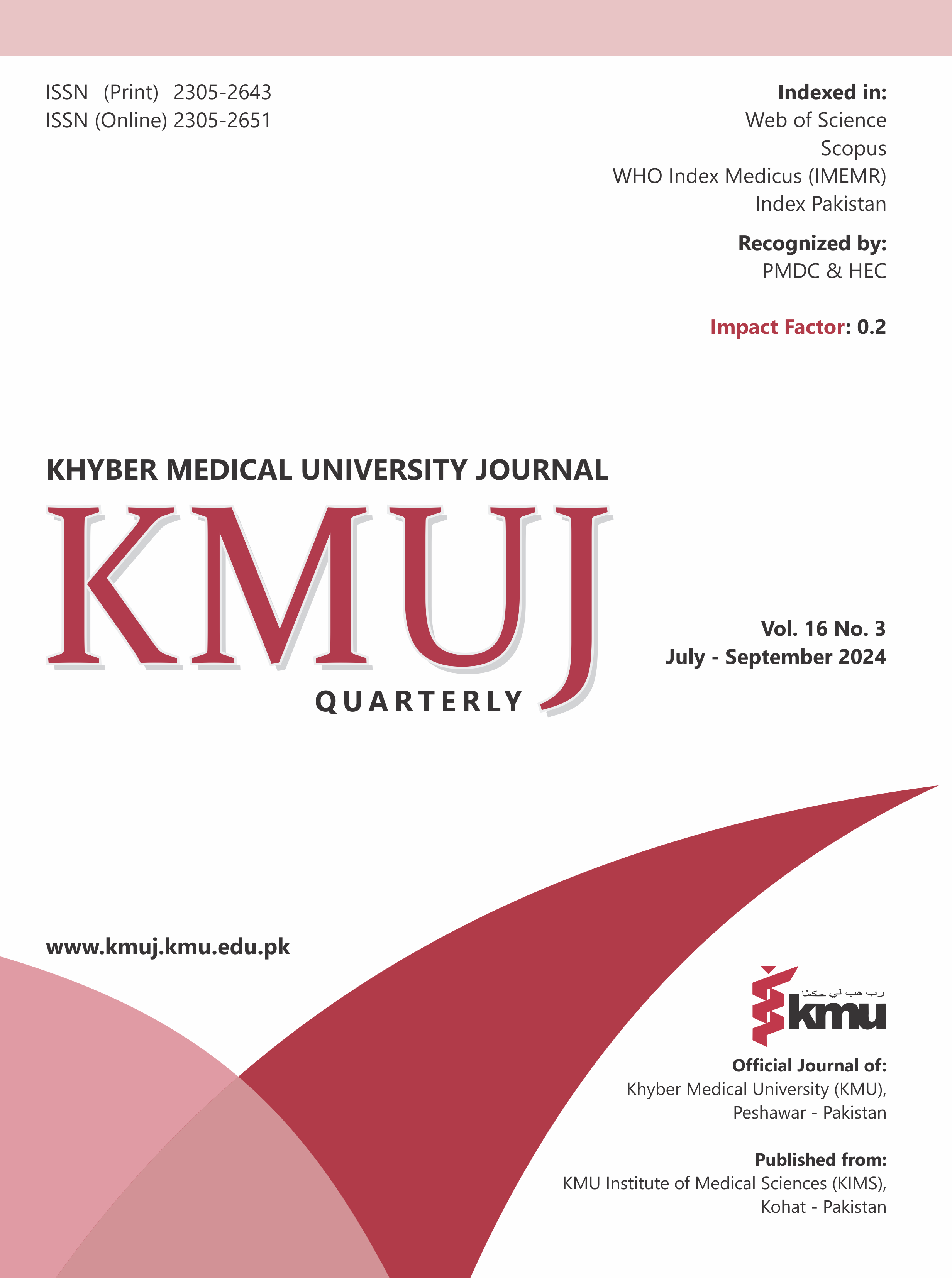Antimicrobial susceptibility patterns of Linezolid-resistant coagulase-negative staphylococci in Pakistan
Main Article Content
Abstract
OBJECTIVE: To determine the antimicrobial resistance pattern in Linezolid-resistant coagulase negative staphylococcus (CoNS) isolates in Pakistan.
METHODS: This cross-sectional study was conducted from February and July 2022, at a private laboratory in Lahore, with samples collected from various regions across Pakistan. The study included microbiological samples such as blood and wound specimens, from which 4,153 isolates of CoNS were identified. Of these, only 64 isolates that were both coagulase-negative and Linezolid-resistant were selected for further investigation. The antimicrobial susceptibility patterns of these Linezolid-resistant isolates were analyzed. The antibiotics tested included amikacin, ciprofloxacin, clindamycin, doxycycline, erythromycin, fusidic acid, gentamicin, oxacillin, teicoplanin, trimethoprim-sulfamethoxazole, and vancomycin. Data analysis was performed using SPSS version-22.
RESULTS: Among 4153 samples, 64 (1.54%) were Linezolid-resistant CoNS isolates, predominantly from adults (aging 18-59 years) and senior adults (aging >59 years), with a higher prevalence in males (56.3%). Resistance was observed in 51.6% of blood and 48.4% of pus samples. Most isolates were also resistant to teicoplanin (100%), ciprofloxacin (92.2%), oxacillin (89.1%), and fusidic acid (84.4%), while sensitivity was highest for vancomycin (85.9%) and doxycycline (79.7%). Statistically significant differences were noted for all antibiotics except erythromycin.
CONCLUSION: Our findings highlight the importance of monitoring the evolution of Linezolid resistance in CoNS as Linezolid resistant isolates also showed high resistance to some other major antimicrobial drugs (e.g. teicoplanin, ciprofloxacin, oxacillin etc.). Linezolid resistance must be closely monitored, especially when frequent and prolonged Linezolid therapy is indicated to implement control measures and reduce the risk of CoNS spreading in the community.
Article Details

This work is licensed under a Creative Commons Attribution 4.0 International License.
Work published in KMUJ is licensed under a
Creative Commons Attribution 4.0 License
Authors are permitted and encouraged to post their work online (e.g., in institutional repositories or on their website) prior to and during the submission process, as it can lead to productive exchanges, as well as earlier and greater citation of published work.
(e.g., in institutional repositories or on their website) prior to and during the submission process, as it can lead to productive exchanges, as well as earlier and greater citation of published work.
References
1. Kosecka-Strojek M, Sadowy E, Gawryszewska I, Klepacka J, Tomasik T, Michalik M, et al. Emergence of linezolid-resistant Staphylococcus epidermidis in the tertiary children’s hospital in Cracow, Poland. Eur J Clin Microbiol Infect Dis 2020;39(9):1717-25. https://doi.org/10.1007/s10096-020-03893-w
2. Mittal G, Bhandari V, Gaind R, Rani V, Chopra S, Dawar R, et al. Linezolid resistant coagulase negative staphylococci (LRCoNS) with novel mutations causing blood stream infections (BSI) in India. BMC Infect Dis 2019;19(1):717. https://doi.org/10.1186/s12879-019-4368-6
3. Shinabarger D. Mechanism of action of the oxazolidinone antibacterial agents. Expert Opin Investig Drugs 1999;8(8):1195-202. https://doi.org/10.1517/13543784.8.8.1195
4. Tewhey R, Gu B, Kelesidis T, Charlton C, Bobenchik A, Hindler J, et al. Mechanisms of Linezolid Resistance among Coagulase-Negative Staphylococci Determined by Whole-Genome Sequencing. mBio 2014;5(3):e00894-14. https://doi.org/10.1128/mBio.00894-14
5. Azhar A, Rasool S, Haque A, Shan S, Saeed M, Ehsan B, Haque A. Detection of high levels of resistance to linezolid and vancomycin in Staphylococcus aureus. J Med Microbiol 2017;66(9):1328-31. https://doi.org/10.1099/jmm.0.000566
6. Jian J, Chen L, Xie Z, Zhang M. Dissemination of cfr-mediated linezolid resistance among Staphylococcus species isolated from a teaching hospital in Beijing, China. J Int Med Res 2018;46(9):3884-9. https://doi.org/10.1177/0300060518781636
7. O'Connor C, Powell J, Finnegan C, O'Gorman A, Barrett S, Hopkins K, et al. Incidence, management and outcomes of the first cfr-mediated linezolid-resistant Staphylococcus epidermidis outbreak in a tertiary referral centre in the Republic of Ireland. J Hosp Infect 2015;90(4):316-21. https://doi.org/10.1016/j.jhin.2014.12.013
8. Hannan A, Absar M, Usman M, Naeem T, Saleem S, Arshad M. In vitro activity of linezolid against clinical isolates of methicillin resistant Staphylococcus. J Ayub Med Coll Abbottabad 2009;21(1):106-9.
9. Afzal R, Nida S, Saeed MZ, Khalil H. Emergence Of Linezolid Resistance In Coagulase-Negative Staphylococcus Isolated From A Post-Surgical Case Of Coronary Artery Bypass At A Tertiary Care Cardiac Setup In Pakistan. Pak Armed Forces Med J 2018;68(1):S208-9.
10. Clinical and Laboratory Standards Institute (CLSI). Performance Standards for Antimicrobial Susceptibility Testing. 32nd ed. CLSI supplement M100. Malvern, PA: Clinical and Laboratory Standards Institute; 2022. Accessed on: January 10, 2022. Available from URL: https://clsi.org/about/press-releases/clsi-publishes-m100-performance-standards-for-antimicrobial-susceptibility-testing-32nd-edition/
11. Khan MM, Faiz A, Ashshi AM. Clinically significant Coagulase Negative Staphylococci and their antibiotic resistance pattern in a tertiary care hospital. J Pak Med Assoc 2014;64(10):1171-4.
12. Gu B, Kelesidis T, Tsiodras S, Hindler J, Humphries RM. The emerging problem of linezolid-resistant staphylococcus. J Antimicrob Chemother 2012;68(1):4-11. https://doi.org/10.1093/jac/dks354
13. Karavasilis V, Zarkotou O, Panopoulou M, Kachrimanidou M, Themeli-Digalaki K, Stylianakis A, et al. Wide dissemination of linezolid-resistant Staphylococcus epidermidis in Greece is associated with a linezolid-dependent ST22 clone. J Antimicrob Chemother 2015;70(6):1625-9. https://doi.org/10.1093/jac/dkv028
14. Latif M, Usman J, Gilani M, Munir T, Mushtaq M, Anjum R. Coagulase negative staphylococci - a fast emerging threat. J Pak Med Assoc 2015;65(3):283-6.
15. Srinivasan L, Evans JR. Health Care-Associated Infections. In: Gleason CA, Juul SE (editors), Avery's diseases of the newborn. 10th edition. Elsevier, Washington, USA. 2018;566-80. ISBN: 978-0-323-40139-5. https://doi.org/10.1016/B978-0-323-40139-5.00040-1
16. Al Tayyar IA, Al-Zoubi MS, Hussein E, Khudairat S, Sarosiekf K. Prevalence and antimicrobial susceptibility pattern of coagulase-negative staphylococci (CoNS) isolated from clinical specimens in Northern of Jordan. Iran J Microbiol 2015;7(6):294-301.
17. Mittal G, Bhandari V, Gaind R, Rani V, Chopra S, Dawar R, et al. Linezolid resistant coagulase negative staphylococci (LRCoNS) with novel mutations causing blood stream infections (BSI) in India. BMC Infect Dis 2019;19:717. https://doi.org/10.1186/s12879-019-4368-6
18. Nicolosi D, Cinà D, Di Naso C, D’Angeli F, Salmeri M, Genovese C. Antimicrobial resistance profiling of coagulase-negative staphylococci in a referral center in South Italy: A surveillance study. Open Microbiol J 2020;14(1):91-7. https://doi.org/10.2174/1874285802014010091
